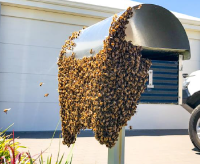Found a swarm?
If you have a bee swarm in your backyard or local area please do not try and kill or interfere with the bees – you are likely to anger the bees and get stung. The bees will not harm you if they are left alone!
Remember the important role bees play in the pollination of agricultural crops, such as many of our nuts, fruit and vegetables.
Why not try to contact a beekeeper to have the swarm removed and placed in a beehive?
Bee swarms are a relatively common occurrence in September, October and November in Australia but can be found at other times of the year too. Swarming is a response to lack of space in the hive and typically happens as spring nectar flows start and hive numbers need to expand. A decision is made by the hive to take the Queen and her workers to a new, spacious home where they can maximise the nectar on offer.
When bees swarm they are most unlikely to sting, so despite their appearance, people should not fear them, just treat them with respect. When a cluster of bees is seen hanging on a tree branch or similar, they are NOT thinking of setting up home there! They are in transition, clustered around their Queen and waiting for the scout bees to find new accommodation.
This is the best time to remove them – before they make a permanent home somewhere inconvenient and become a feral hive.
Once the scouts find a place to stay the swarm will move to their new location and set up their hive. They will quickly start making comb so the Queen can begin laying and worker bees can begin storing honey supplies. Once they have established themselves they are no longer considered to be a swarm and their placid nature can change.
Typically these new homes will be in holes in established trees, water meter boxes (a favourite location), inside furniture left on your verandah, in gaps between double brick walls, behind weatherboards or any number of inconvenient locations for humans. And getting them out can be tricky. Sometimes accessing bees in these locations may require weatherboards or bricks to be removed.
Contacting a beekeeper
Many amateur beekeepers will collect swarms in their local area as a community service. The beekeeper will need to know the exact location of the swarm, its size and how long it has been there. They will need to be able to get a beebox to the swarm and may leave the box there for a day or two. They will probably collect the bee box at night. Remember to check to see if they charge any fee to cover expenses.
It will help the swarm collector if you can provide photos of the swarm.

Beekeepers
If you are a member of the Amateur Beekeepers Association, and would like to be listed to collect swarms, please register for a Swarm collector account.
Find a Beekeeper
Enter the postcode of the suburb where the swarm is located (includes NSW and SE Qld)
Disclaimers:
The Amateur Beekeepers Guild provides the information in Find a Beekeeper above only for the purposes of allowing interested persons to contact individuals regarding bee related issues. Any agreement, engagement or activity that may be undertaken thereafter, by persons contacting individuals on the Swarm Collectors list, is at their own risk and liability.
The Amateur Beekeepers Guild does not accept any responsibility whatsoever for issues which may arise as a result of persons contacting individuals named above. All persons are advised to undertake their own due diligence with respect to bee related activities.

